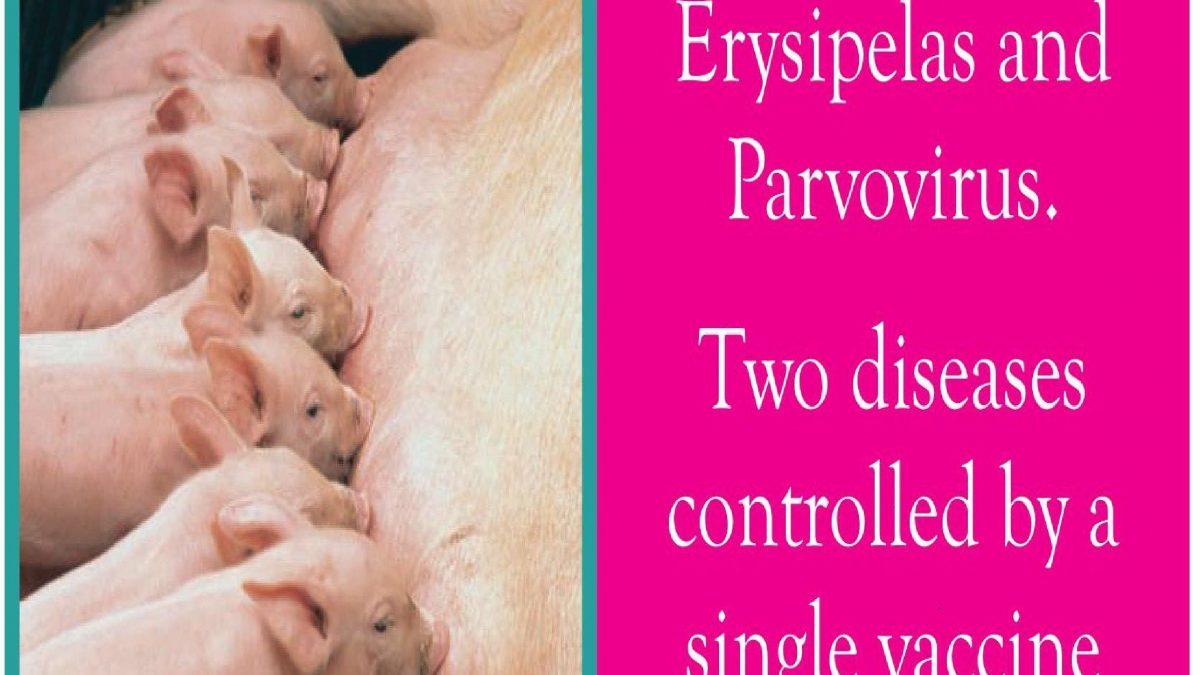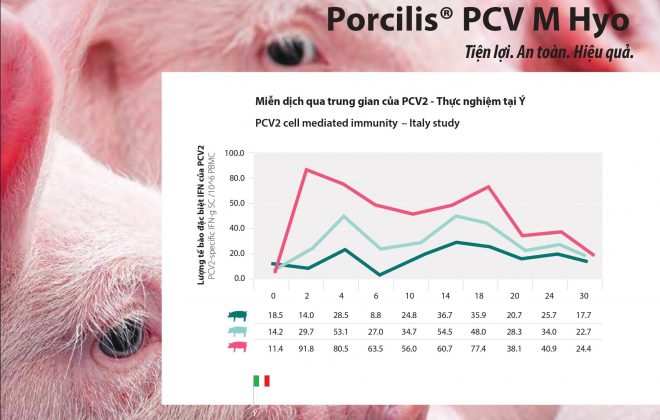Porcilis® Ery+Parvo for the combined control of Erysipelas and Parvovirus
Erysipelas and Parvovirus
Two diseases controlled by a single vaccine
Swine Erysipelas
The Problem
Erysipelas is an infectious disease causing reproductive failure in sows and boars, also arthritis and lameness, heart disease and, in acute cases, death. It can affect growing pigs and adult stock.
The Cause
The disease is caused by the bacterium Erysipelothrix rhusiopathiae, which is found in soil, straw, and in feed and water contaminated with faeces and urine from infected pigs and birds. Straw based and outdoor systems are therefore most at risk.
Although a number of different serotypes of E.rhusiopathiae can be identified in the field, it has been found that certain strains of serotype 2 (as used in Porcilis Ery and Ery+Parvo) will produce effective killed vaccines which will then cross protect against disease caused by other serotypes.
The Effects
The type of losses incurred depend on the age of the pig and the stage of production at which infection occurs. Any of the following may then be experienced: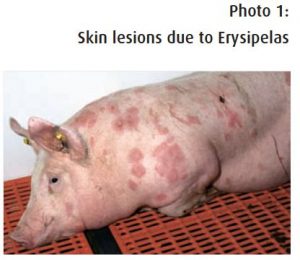
• Abortion and reproductive failure
• Infertility of boars for at least 2 months due to fever
• Premature culling of breeding stock due to lameness
• Carcass condemnation due to arthritis & skin damage
• Sudden deaths
Porcine Parvovirus
The Problem
Porcine Parvovirus (PPV) is an infectious disease that kills developing piglets in the uterus of non-immune sows and gilts. It is a significant cause of reproductive failure and economic loss in non-immune herds, in which outbreaks still regularly occur.
The Cause
Porcine Parvovirus is widespread in the UK – reports indicate that more than 90% of herds may be infected. The virus enters via the mouth, then multiplies and travels via the bloodstream to the uterus. Within 3 weeks of infection, it crosses the placenta and attacks the developing embryos and foetuses of non-immune sows and gilts.
Dependent upon the stage of pregnancy, the effects of PPV will vary (see table below).

The Effects 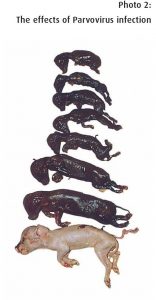
• Increased irregular returns to service
• Reduced farrowing rate
• Increased incidence of stillbirths and mummified pigs
• Low numbers of pigs born alive per litter
• Increased variability of pigs born and litter size
• Reduced piglet viability
Which breeding stock are most at risk to Parvovirus infection?
Gilts: whether brought in or homebred, are most susceptible to Parvovirus. This is due to maternally derived antibodies persisting, and then declining rapidly between 4-5 months of age. The non-vaccinated gilt is then highly susceptible to infection with PPV from older sows when integrated into the breeding herd. Gilts must be vaccinated after 5 months of age and at least 2 weeks prior to mating.
Sows: immunity levels change over time; whilst immunity by exposure can give protection, it is not precise and can not be fully relied upon; an annual booster
vaccination is advised.
Boars: PPV does not affect the boar or semen quality, but infected boars can transmit the virus in their semen, infecting sows. Boars should therefore be routinely vaccinated.
Porcilis Ery+Parvo vaccine
For the prevention of Erysipelas & Parvovirus 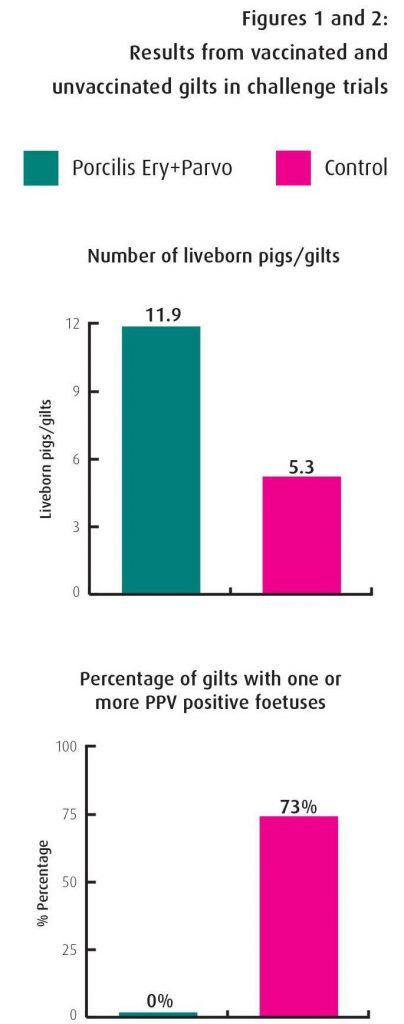
Porcilis Ery+Parvo is a 2 in 1 combination vaccine containing inactivated highly immunogenic strains of Erysipelothrix rhusiopathiae and Porcine Parvovirus (PPV), together with Intervet’s unique non-mineral oil adjuvant Diluvac® Forte.
Efficacy
The efficacy of the Erysipelas and Parvovirus components of Porcilis Ery+Parvo vaccine has been assessed and proven in challenge studies.
Porcine Parvovirus (PPV) component efficacy Groups of non-immune gilts were either vaccinated with Porcilis Ery+Parvo 2 weeks before mating, or left as unvaccinated controls. Both groups were then challenged with PPV 40 days post mating (Figs 1 and 2).
These results show that a single vaccination with Porcilis Ery+Parvo provides comprehensive protection against losses caused by Parvovirus infection. Further trials have shown that protection induced by a single dose of this vaccine lasts for at least
a year.
Erysipelas component efficacy Groups of non-immune pigs were either vaccinated at 20 and 24 weeks with Porcilis Ery+Parvo vaccine, or were left as unvaccinated controls. They were then challenged 3 weeks later (using a serotype 1 strain to prove crossprotection) and the following results were obtained:

Additional studies have shown that protection against Erysipelas is maintained for 6 months following vaccination. A booster vaccination using either Porcilis Ery+Parvo or Porcilis Ery vaccine is therefore recommended, either on a per litter basis or 6 monthly.
Vaccination Programmes
A complete system for protection Accompanying Intervet’s Porcilis Ery+Parvo vaccine is the erysipelas-only version, Porcilis Ery. Together the vaccines give complete and ongoing protection against both these costly diseases, as shown in the diagram below:
These vaccination programmes have been developed for ease of management – so booster vaccinations are given when sows are in the farrowing area, and are more accessible. They may also be safely given at weaning or during pregnancy. Both vaccines are given by intramuscular injection, which is easier to give and more reliable than subcutaneous vaccination. Please take your veterinary surgeon’s advice in respect of any alternative regimes.
Gilts and Unvaccinated Sows 1. To provide protection against Erysipelas and Porcine Parvovirus in unvaccinated gilts give the initial dose of Porcilis Ery+Parvo followed 4 weeks later by a Porcilis Ery, and at least 2 weeks pre-mating, see below:

Porcilis Ery and Porcilis Ery+Parvo are given intramuscularly using a needle of at least 1.5 inches (40mm) in length for sows. A similar vaccination schedule may be used
for boars.
Booster Vaccinations The duration of immunity against Erysipelas is 6 months, whereas the duration for Parvovirus is at least 12 months.
| The most practical regime in terms of implementation is to vaccinate all sows, either during lactation or at weaning, with Porcilis Ery+Parvo for 6 consecutive months. For the remaining 6 consecutive months simply vaccinate with Porcilis Ery, repeat this regime annually. Consult your veterinary surgeon for alternative regimes. |
Diluvac® Forte – New Adjuvant Technology 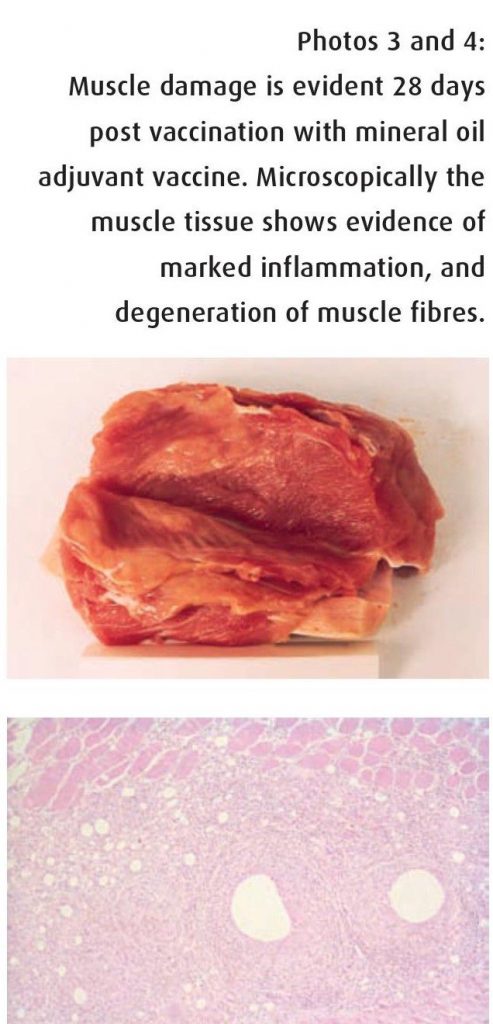
Adjuvants are used in vaccines to increase the stimulation of the pigs’ immune system, so increasing the level of protection against the disease. A unique non- mineral oil adjuvant called Diluvac Forte, developed and patented by Intervet, is used in Porcilis Ery+Parvo and Porcilis Ery. It has potent immune stimulant properties, and provides 150mg Vitamin E per 2ml injection.
Diluvac Forte has many other advantages over traditional mineral oil adjuvants:
• Safer for the user – does not present the serious risks associated with mineral oil adjuvants should accidental self-injection occur
• Ease of use – does not ‘foam’ or cause air locks in the syringe. It also flows easily, even at low temperatures. Syringes are easily cleaned after use, and because the adjuvant is non-oily, syringe plungers and washers do not perish.
• Welfare friendly – does not damage pig tissue as can occur with mineral oil products, as shown in the adjacent images.

Porcilis Ery+Parvo inactivated E.rhusiopathiae and porcine parvovirus vaccine.
Advice on the use of these products should be sought from your veterinary surgeon.
Contra-indication, warnings etc for all vaccines
Do not vaccinate unhealthy or pregnant animals. Do not mix with other vaccines or substances. Other vaccines should not be given within 14 days before or after vaccination with Porcilis Ery+Parvo. Transient temperature rise, slight temporary swelling and some reluctance to move may occur.
Withdrawal periods: Nil. Legal categories POM-V
Package quantities
Porcilis Ery+Parvo, 10 dose (20ml) and 25 doses (50ml)

